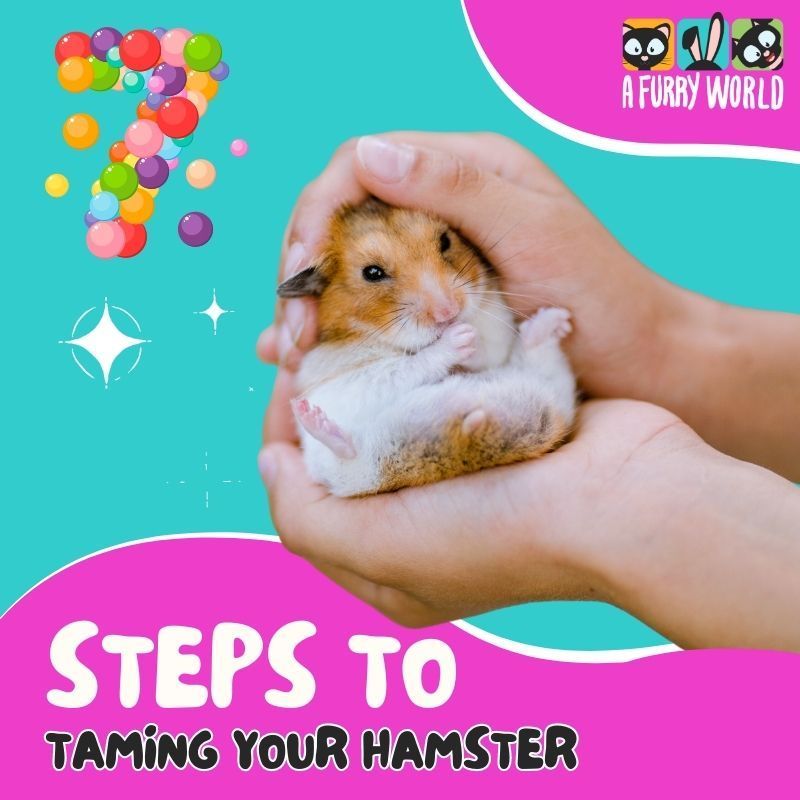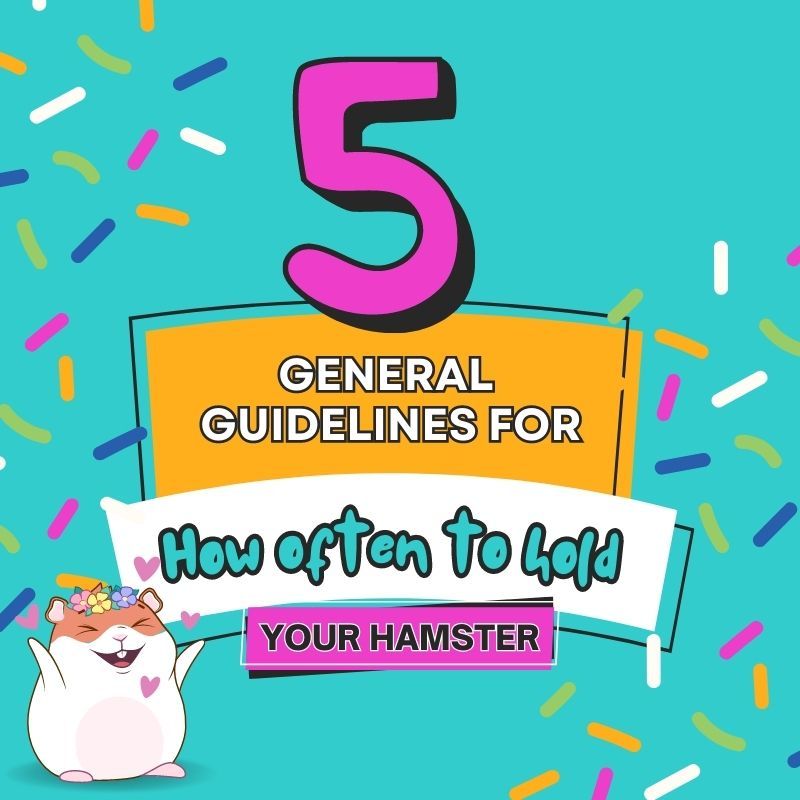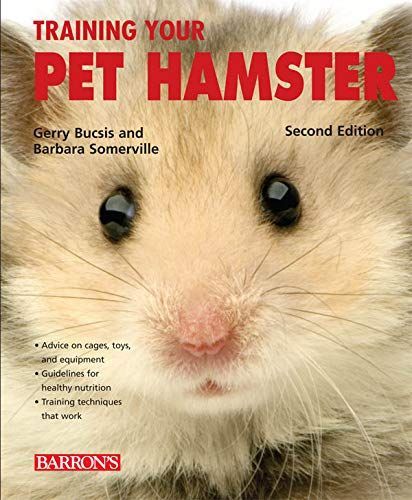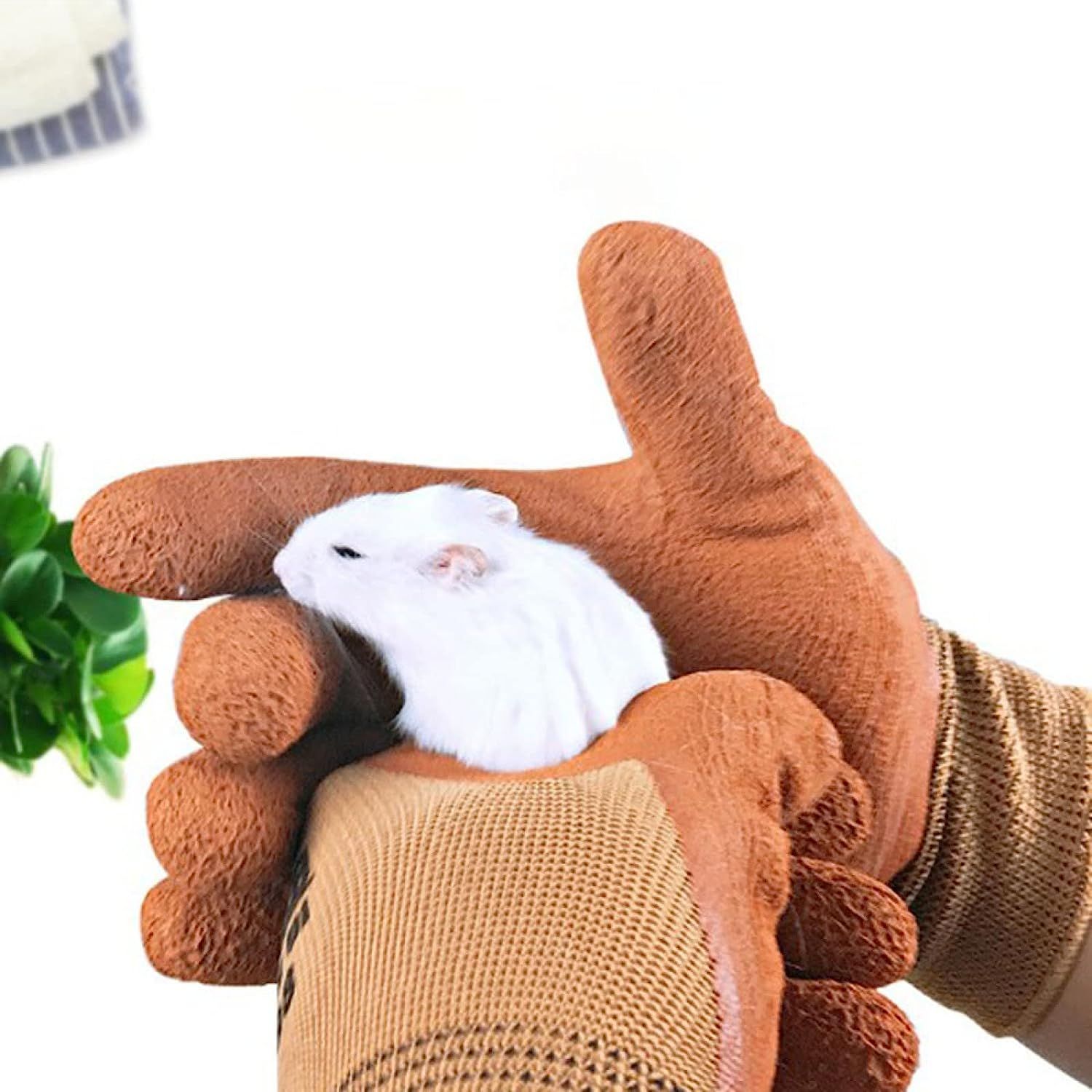How to Tame and Handle my new hamster
Unlocking the Magic of Hamster Companionship
Welcome to a world of tiny paws, twitchy noses, and boundless affection! If you've recently welcomed a charming new hamster into your life, get ready for a heart-warming adventure filled with joy, laughter, and an unbreakable bond. In this blog, we're excited to share with you information about taming and handling your new hamster.
Like all new relationships, the process of taming and bonding with your new hamster requires patience, understanding, and a dash of gentle magic.
Whether you're a seasoned pet parent or a first-time hamster enthusiast, we hope to inspire you with, practical insights, and delightful discoveries that come with sharing your life with a new furry friend.
So, grab a cup of tea, find a cosy spot, and let's embark on a delightful adventure together! Get ready to unlock the magic of hamster companionship as we delve into the art of taming and handling your new, lovable hamster. Happy hamster parenting! 🐹💕

In this blog, we will explore answers to some of the most commonly asked questions about taming and handling your new hamster, including the question; How do I tame my hamster?
Taming a hamster requires patience, consistency, and gentle handling. Here are some steps you can follow to help tame your hamster:
- Give it time: Allow your hamster to settle into its new environment for a few days without handling it. This will help it feel more secure in its surroundings.
- Gradual approach: Start by placing your hand near the cage for short periods each day so the hamster becomes accustomed to your presence and scent. Talk softly to it so it gets used to your voice.
- Offer treats: Hamsters are motivated by food, so use treats to create positive associations. Start by placing a treat on your open palm and let the hamster approach and take it. Do this consistently, gradually moving the treat from your palm to your fingers.
- Hand feeding: Once your hamster is comfortable taking treats from your hand, start hand feeding it regularly. This will help it associate your hand with positive experiences and build trust.
- Slowly introduce handling: Once your hamster is comfortable with hand feeding, you can begin gently scooping it up with cupped hands. Always approach from the side or below to avoid scaring the hamster. Be patient and avoid sudden movements.
- Short handling sessions: Start with short handling sessions of a few minutes each day, gradually increasing the duration over time. Pay attention to your hamster's behaviour and if it shows signs of stress (such as biting or trying to escape), return it to its cage and try again later.
- Provide a safe environment: Make sure the room is quiet, secure, and free from any potential hazards while handling your hamster. Close any doors and windows to prevent escape, and ensure there are no other pets present.
Remember, each hamster has its own personality and may take varying amounts of time to become fully tame. It's important to be patient, consistent, and gentle throughout the taming process. Avoid forcing the hamster to do anything it is uncomfortable with, as this can hinder progress and damage trust.
How long does it take to tame a hamster?
The time it takes to tame a hamster can vary from one individual to another. Some hamsters may become comfortable with handling within a few days or weeks, while others may take several weeks or even months. It depends on various factors such as the hamster's personality, previous experiences, and the consistency of your interactions with it.
The key is to be patient, consistent, and gentle in your approach. Building trust takes time, and every hamster has its own pace of adaptation. Remember to respect your hamster's boundaries and allow it to progress at its own comfort level. Rushing or forcing the taming process can cause setbacks and make it more challenging to build trust.
Continue to provide positive experiences, such as offering treats, hand-feeding, and gentle handling. Gradually increase the duration and frequency of handling sessions as your hamster becomes more comfortable. With time and consistent effort, most hamsters can be tamed and become comfortable with human interaction.
ALL THINGS HAMSTERS FOR KIDS
Is a book for the whole family filled With Plenty of Facts, Photos, and Fun to Learn all About Hamsters.
The book is colourful and filled with stunning images, it blends fun with education in simple and easy-to-understand writing for readers 6 years old and upwards.
It offers plenty of incredible facts and topics ranging from their history, evolution, characteristics, diet, and life cycle.
TRAINING YOUR PET HAMSTER
By Author: Gerry Bucsis
This book provides advice on getting acquainted with your new pet, information on pet behaviour, tips on hassle-free travel, and suggested games to teach your pet.
Topics specific to hamster care include: Correct handling of hamsters, Equipment and toys suited for hamsters, Advice on food, health care, and much more
How do you get a hamster to trust you?
Building trust with a hamster requires patience, consistency, and positive interactions. Here are some tips to help your hamster trust you:

- Respect its space: Give your hamster time to adjust to its new environment without trying to handle or interact with it right away. Allow it to explore its cage and become familiar with its surroundings.
- Slow and gentle approach: When you do begin interacting with your hamster, approach it calmly and gently. Avoid sudden movements or loud noises that may startle it. Place your hand near the cage and allow your hamster to approach and sniff you at its own pace.
- Hand-feeding: Use treats and food to create positive associations with your presence. Start by offering treats from your open palm and gradually progress to hand-feeding. This will help your hamster associate your hand with positive experiences.
- Regular and consistent interaction: Spend time near your hamster's cage each day, talking softly to it so it becomes familiar with your voice and presence. Gradually increase the amount of time you spend interacting with it, but always be patient and respectful of its comfort level.
- Bonding through scent: Hamsters have a strong sense of smell. You can place a small piece of fabric or tissue in your hand or clothing to transfer your scent to it. Then, place the scented fabric in the hamster's cage so it becomes accustomed to your smell.
- Gradual handling: Once your hamster is comfortable with your presence, you can start with short handling sessions. Begin by gently scooping it up with cupped hands and gradually increase the duration of handling over time. Always approach from the side or below to avoid causing stress.
- Consistency and trust-building activities: Maintain a consistent routine of interacting with your hamster, providing food, and engaging in gentle handling. Avoid sudden changes or disruptions that may cause stress. Over time, your hamster will begin to associate you with positive experiences and build trust.
Remember, trust takes time to develop, and each hamster is unique. Be patient, understanding, and respectful of your hamster's boundaries. Avoid any actions that may cause fear or stress. With consistent and positive interactions, your hamster will gradually learn to trust you.
Can MY hamster bond with you?
Yes, hamsters are capable of forming bonds with their owners. While the level of bonding can vary from hamster to hamster, many hamsters do develop a strong bond with their human caregivers. Building a bond with a hamster requires time, patience, and consistent positive interactions.
Hamsters are social animals and can become accustomed to their owners' presence, recognize their scent, and even display signs of affection. Some common signs of bonding in hamsters include approaching their owners willingly, seeking interaction, grooming behaviours, and even climbing onto their owners' hands or laps.
To strengthen the bond with your hamster, spend quality time with it each day, offering treats, engaging in gentle handling, and providing a stimulating and comfortable environment. Consistency is key in establishing trust and building a strong bond. By being a caring and attentive caregiver, you can foster a positive relationship with your hamster and enjoy the rewards of a bonded companionship.

How do I bond with my hamster?
Bonding with a hamster involves creating a positive and trusting relationship through regular interactions and care. Here are some ways to bond with your hamster:
- Spend time near the hamster: Begin by spending time near your hamster's cage, talking softly to it, and allowing it to become familiar with your presence and voice. This helps the hamster associate you with safety and comfort.
- Hand-feeding and treats: Use treats and food to create positive associations. Start by offering treats from your open palm and gradually progress to hand-feeding. This helps your hamster associate your hand with positive experiences and build trust.
- Gently handle your hamster: Once your hamster is comfortable with your presence and hand-feeding, you can begin gentle handling. Approach your hamster from the side or below to avoid startling it. Scoop it up with cupped hands and gradually increase the duration of handling over time. Be patient and avoid forcing any interactions.
- Provide a stimulating environment: Ensure your hamster's cage is enriched with toys, tunnels, and activities to keep it mentally and physically stimulated. Interact with your hamster through play, such as providing puzzle toys or supervised exploration outside the cage in a safe, hamster-proofed area.
- Respect your hamster's boundaries: Each hamster has its own comfort level and personality. Respect your hamster's need for rest and privacy. Avoid overwhelming it with too much handling or interaction. Allow your hamster to initiate contact and take breaks when needed.
- Establish a routine: Hamsters thrive on routine and consistency. Establish a regular schedule for feeding, cleaning, and interaction. This helps your hamster feel secure and builds trust over time.
- Be patient and gentle: Building a bond takes time and patience. Avoid sudden movements, loud noises, or any actions that may startle or frighten your hamster. Remain calm, gentle, and understanding throughout the bonding process.
Remember that bonding with a hamster is a gradual process, and each hamster has its own unique personality. Some hamsters may bond more quickly, while others may take longer. Be consistent, attentive, and respectful of your hamster's needs, and with time, your bond will strengthen.
Anti-Bite Gloves
Feel that you need to protect your fingertips, hands and arms from pain, infectious bites and scratches these gloves can be very useful.
Using thirteen needle polyester weave, making the gloves breathable and comfortable. The palm and fingertips are impregnated with latex, which has a good grip and good anti-slip effect.
Designed for small pets such as hamsters, hedgehogs, squirrels, and perfect for hand protection.
HAMSTER TREATS - ASSORTED FRUITS
During training treats are a great added too. Why not try these JONSANTYGFRY hamsters treats.
This is a snack based on dried fruit granules is a healthy snack that is made with a variety of delicious fruits, including strawberries, bananas, grapes and apples.

How do I best pick my hamster up?
When picking up a hamster, it's important to approach them with care to ensure their safety and comfort. Here's a step-by-step guide on how to best pick up your hamster:
- Prepare the environment: Make sure you are in a quiet and secure area, free from any potential hazards. Close any doors and windows to prevent escape, and ensure there are no other pets around.
- Approach from the side: Slowly and gently approach your hamster from the side rather than from above. This helps avoid startling them and reduces the likelihood of them feeling threatened.
- Use cupped hands: Place one hand on each side of your hamster, creating a cupping shape with your hands. Make sure your fingers are gently curled, creating a secure and comfortable spot for your hamster to sit.
- Lift smoothly and support the body: Lift your hamster smoothly, using both hands to support their body. Avoid squeezing or gripping tightly. Provide gentle support and ensure your hamster feels secure in your hands.
- Keep your hands close to the ground: Keep your hands close to the ground or a secure surface to minimize the distance your hamster will fall if they happen to jump or wriggle out of your hands.
- Be calm and confident: Stay calm and confident while handling your hamster. Sudden movements or nervousness can startle them. Speak softly to reassure them during the process.
- Handle with care: Once you have your hamster in your hands, you can gently bring them close to your body or place them in a secure container or play area. Always supervise them closely during handling and never leave them unattended.
It's important to note that not all hamsters enjoy being held or handled extensively. Some hamsters may be more skittish or prefer limited handling. Always respect your hamster's comfort level and don't force them to be held if they show signs of stress or discomfort.
Each hamster has its own personality, and it may take time for them to get used to being handled. Be patient, gentle, and understanding, and allow your hamster to dictate the pace of handling.

How often should I hold my hamster?
The frequency of handling your hamster can vary depending on its personality and preferences. It's important to find a balance between providing social interaction and respecting your hamster's need for rest and privacy. Here are some general guidelines for handling your hamster:
- Start slowly: When you first bring your hamster home, give it a few days to settle into its new environment without handling it. This allows the hamster to adjust and feel more secure in its surroundings.
- Gradual increase in handling: Once your hamster has settled in, you can begin gradually increasing the frequency and duration of handling sessions. Start with short sessions of a few minutes each day, and observe your hamster's behaviour. If it appears comfortable and relaxed, you can gradually increase the time spent handling.
- Monitor your hamster's response: Pay attention to your hamster's body language and behaviour during handling. If it seems stressed, shows signs of agitation, tries to escape, or becomes aggressive (e.g., biting), it may be a sign that it needs more time to adjust or that it prefers less handling. Respect your hamster's boundaries and adjust the frequency of handling accordingly.
- Provide alternative interactions: Remember that handling is not the only form of interaction with your hamster. You can also engage in playtime outside of the cage in a safe and supervised environment, offer treats and toys, or simply spend time near the cage talking softly to your hamster. These interactions can also help strengthen your bond.
- Individual preferences: Each hamster is unique, and some may enjoy more handling and social interaction, while others may prefer less. It's important to observe and respect your hamster's preferences and adjust your interactions accordingly.
It's also worth noting that hamsters are nocturnal creatures, so they are generally more active during the evening and night. Taking this into consideration, it may be better to handle your hamster in the evening when it's more likely to be awake and active.
Overall, the key is to find a balance that suits both your hamster's comfort level and your desire for interaction. By paying attention to your hamster's behaviour and adjusting your approach accordingly, you can provide appropriate handling and socialization opportunities for your furry friend.

Do’s and don’ts of handling a hamster
When handling a hamster, it's important to follow some do's and don'ts to ensure the safety and well-being of your pet. Here are some guidelines:
Do’s
- Approach gently: Approach your hamster slowly and gently, allowing it to see and sniff your hand before attempting to pick it up.
- Wash your hands: Wash your hands with unscented soap and warm water before handling your hamster. This removes any strong scents or residue that may bother or confuse your hamster.
- Use both hands: Support your hamster's body with both hands when picking it up. Cup your hands securely around it, providing gentle support and comfort.
- Keep a secure grip: Maintain a firm but gentle grip on your hamster to prevent it from wriggling or jumping out of your hands. Be cautious and ensure it cannot escape or fall from a height.
- Be calm and patient: Stay calm and patient while handling your hamster. Sudden movements or loud noises can startle and stress them. Speak softly and provide a soothing presence.
- Supervise closely: Always supervise your hamster closely while handling it to prevent accidents or injuries. Keep them away from dangerous areas, such as edges or open spaces.
Dont’s
- Don't force handling: Never force your hamster to be held or handled if it shows signs of stress or discomfort. Respect its boundaries and give it time to adjust to handling at its own pace.
- Avoid sudden movements: Sudden movements can startle your hamster and cause it to feel threatened. Move slowly and gently when interacting with your pet.
- Avoid loud noises: Loud noises can frighten your hamster, so try to handle it in a quiet environment. Keep other pets, such as dogs or cats, away during handling sessions.
- Don't squeeze or drop your hamster: Always handle your hamster with care, ensuring a secure grip without squeezing. Avoid dropping or mishandling your hamster, as it can cause injury or stress.
- Avoid waking them from sleep: Hamsters are nocturnal animals and sleep during the day. Avoid waking them abruptly or disturbing their sleep unless necessary.
- Don't handle if unwell: If your hamster is unwell, injured, or showing signs of illness, it's best to avoid handling it and consult a veterinarian for appropriate care.
Remember, every hamster is an individual, and their comfort levels with handling may vary. Pay attention to your hamster's behaviour and adjust your handling approach accordingly. With time, patience, and gentle interactions, you can build a trusting relationship with your hamster.
in Conclusion
As we come to the end of this post we hope you've been filled with excitement, knowledge, and a deep appreciation for the wonders of taming and handling your new hamster. These tiny creatures have a unique way of brightening our lives, and with the right approach, they become cherished members of our families.
Remember, taming a new hamster is a delicate dance of patience and understanding. As you build trust and create a safe space for your furry friend to thrive, you'll witness the blossoming of a beautiful friendship that knows no bounds.
Always cherish the small victories—the first time your hamster accepts a treat from your hand, or the gentle nudge they give when they seek your company. Each milestone is a testament to the bond you've nurtured with care and devotion.
Continue to provide your hamster with love, attention, and a nurturing environment. Embrace their individual quirks and personalities, and relish the uniqueness that each one brings to your life.
And finally, remember that just as you've learned to handle and tame your new hamster, they, too, will teach you invaluable lessons about compassion, resilience, and unconditional love.
May your days be filled with joy, laughter, and countless heartwarming moments with your beloved hamster. As they scurry into your heart, they'll leave behind pawprints of love that will last a lifetime.
Thank you for joining us on this enchanting adventure of hamster companionship. We wish you and your furry friend an extraordinary life together—one that's brimming with happiness, warmth, and the pure magic of friendship. 🐹💖
Thank you for reading this post. We hope that you found it interesting and hope to you visit this page again soon. For more information, fun facts and cute photos, please follow us on social media. 🐹
THANK YOU
Thank you for reading this post. We hope that you found it helpful and hope to you visit this page again soon. For more information, fun facts and cute photos, please follow us on social media. ❤️
Disclosure & Disclaimer: Some of the links in this blog may be affiliate links, which means we earn a small commission if you click through and make a purchase. This comes at no additional cost to you but helps support the continued production of content. We only recommend products and services we believe will add value to our audience. The content provided is solely for informational purposes. Any advice provided is based on personal experience and research and may not be suitable for everyone. Before implementing any advice, please consult with a professional to ensure it's appropriate for your specific situation. Thank you for your support.















